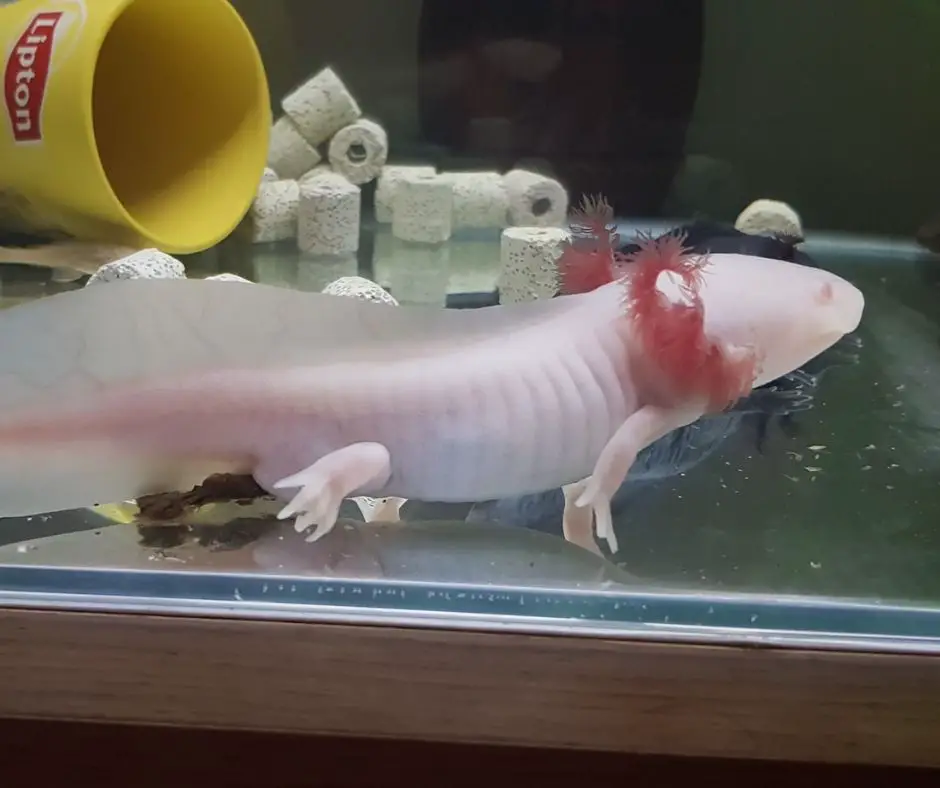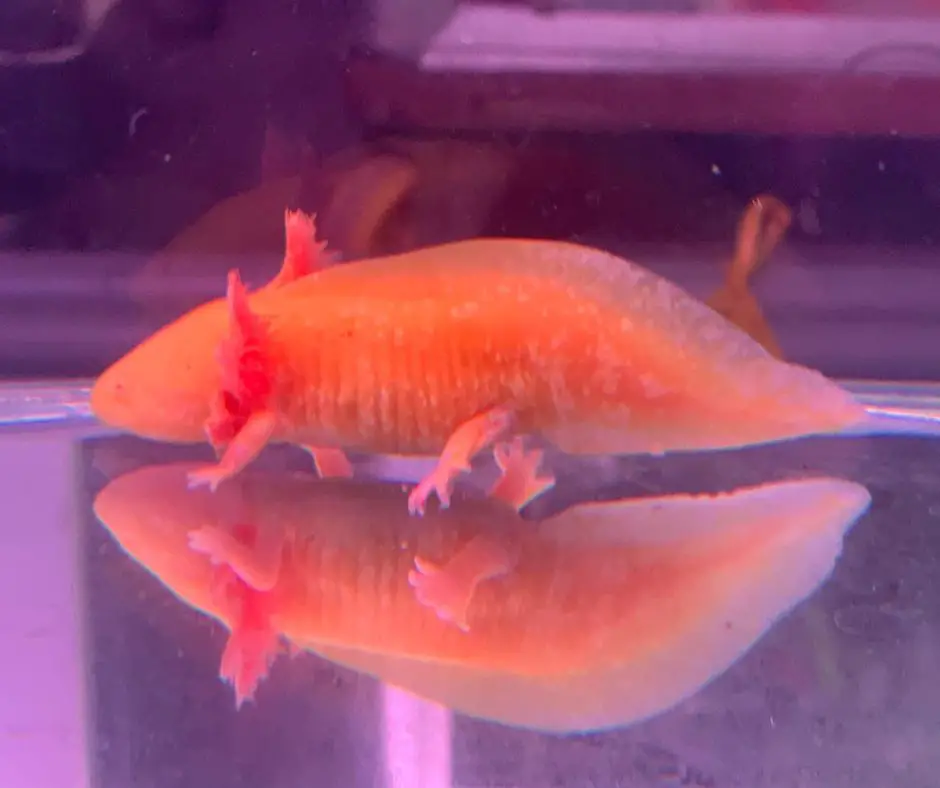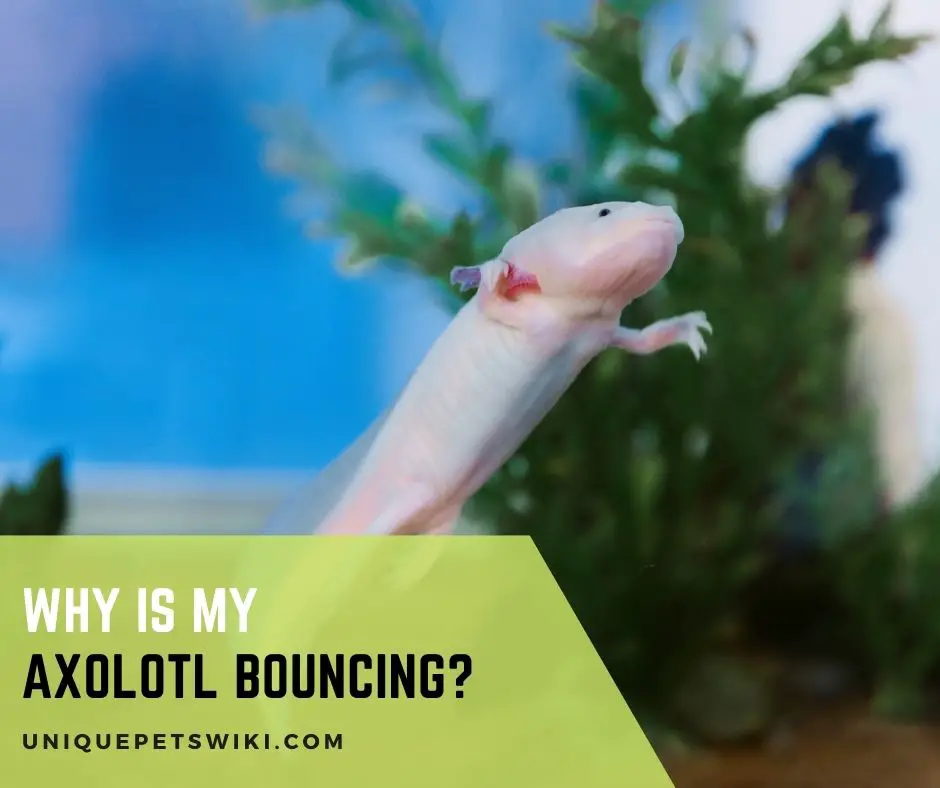If you want to have a fantastic journey raising your axolotl, it’s imperative to understand all its behaviors. For instance, you may wonder, why is my axolotl bouncing?
If you know your axolotl well, most, if not all, of their behaviors are not unknown to you, and you will always know what your pet is trying to tell you.
Axolotls show many different behaviors, and they all communicate something which your axolotl expects you to understand.
Here, we will buckle down to axolotl bouncing, which is a most renowned behavior among these animals. Read the article to know why your axolotl is bouncing.
Contents
Why Is My Axolotl Bouncing?

If your axolotl is bouncing, there is nothing to worry about; bouncing is typical with these animals. Most often, axolotls tend to bounce when eating, especially the young axolotls.
When feeding axolotls, they typically suck water into their mouth to haul the food with it, making them bounce (rise into the water slightly).
Sometimes, axolotls fly up into the water as part of the movement.
However, if you notice your axolotl bouncing continuously without food available, something could be wrong. That happens mostly when an axolotl has hiccups.
Snap At Food
Bouncing is more evident in young axolotls when they try to eat things because of their lightweight. You will often see them bouncing when they snap at food.
They have a sudden potent suction purposely for taking in water and meal in tandem, making them jump up.
Adult axolotls will also jump up but not as their young counterparts. They have a heavier weight, and their suction is most potent, so only their hips manifest a jumping effect.
For instance, imagine a 1.5m tall basketball player trying to throw a ball into the basket; they will create a considerable force when landing their feet on the floor.
Opposingly, a person who is 1m tall will create smaller friction when contacting the surface. It is not different with axolotl, where the young axies bounce in the process of getting food.
A Sign of Stress/Sickness
More often, a stressed axolotl is likely to become sick than comfortable ones. It is disheartening to see your axolotl stressed or sick and no longer show the morale to swim or eat.
Axolotls at old age are at a greater risk of contracting diseases because of their weak immunity and perhaps being inactive most of the time.
When an old axolotl is sick or experiencing stress, you may notice it is somewhat bouncing alongside other signs such as appetite loss, etc.
Bouncing, especially when food is not present, could be a warning sign of stress or sickness.
As a responsible axolotl owner, the best thing you can do is check with your veterinarian to find out the problem.
Axolotl Bounce and Related Problems
At first glance, you may contempt axolotls because of their small size. But upon close interaction with these creatures, you will know there is more to them than meets the eye.
Axolotls do not only bounce, but they display many different behaviors, including twitching, holding still, not moving, and swimming around, among others.
None of these behaviors are reasonless.
You may misunderstand your axolotl if you’re entirely unaware of why an axolotl would behave in a particular manner.
Thus, you need to have all the details about axolotls at your fingertips to enjoy a happy life with your beloved axie. Let’s dig deep into the four mentioned behaviors and see what they symbolize.
Axolotl Not Moving

The nature of an axolotl dictates its activity. For instance, some axolotls show a quieter character and behavior; they hide in their shelter throughout the day and will barely move this time.
Though at night, they are busy exploring the tank.
Your axolotl has no problem if it’s behaving in this manner. But where axolotls show no response even after seeing food and remain tied to one place, that could be a sign of sickness.
A sudden change in water quality or temperature will shock axolotls and can kill them.
These animals also suffer from the shock of transport. These two could be the reasons behind your axie not moving.
Axolotl Swim Around
Generally speaking, axolotls spend most hours in the daytime hiding in their shelter but become overly active at night, where you will hear them stirring the substrates, hitting aquarium rocks, etc.
The young axolotls are more energetic, and you will see them swimming around the tank, not once but frequently. But the adults are somehow inactive and swim less often.
Your young axie constantly swimming or the aged axolotl lazing around is completely normal.
Some axolotls are pretty curious where they enjoy going around, exploring the aquarium, and paying attention to what is going on in the surroundings.
However, some axies are shy, quiet, and exhibit less movement.
Axolotl Holding Still
Sometimes, your axolotl may not appear to be very interested in life, and all you can notice is an immobile and sluggish pet.
Most axolotls, especially adults, grow to become inactive and occasionally move, which is a typical behavior unless accompanied by other symptoms.
Such axolotl is probably relaxing with eyes alert while waiting for a bit of prey to swim by and snap at it.
Axolotl Twitching
Axolotl twitching primarily signifies discomfort. The problem could stem from digestive discomfort, constipation, irritation in the gills, an injury or parasites, nervous system disorder, aggression from tank mates, etc.
Note that an axolotl will twitch in a particular manner depending on what is causing it to do so. Fear can also contribute to an axolotl darting around the tank wildly.
Aqueon 10 Gal Black Aquarium
- High quality glass construction with clean silicone sealed edges
- For freshwater and marine applications as well as desert or tropical terrarium applications
- Tank measures 20.25" long x 10.5" wide x 12.625" high
- Always include a drip loop when plugging aquarium appliances into the electrical outlet
- Place aquarium on a stand that is able to safely bear the weight of a filled aquarium
Last update on 2022-12-30 / Affiliate links / Images from Amazon Product Advertising API
Conclusion
Axolotls are a bit difficult to understand if you don’t take the time to study the many behaviors they display.
Some behaviors are weird, e.g., bouncing, hopping, swimming upside down, twitching, etc., and can leave you mesmerized with no idea how to respond.
Every behavior evident in axolotls tries to explain something to you, which could be related to water quality, axolotl health, or even a change in weather conditions.
Bouncing in axolotl is not uncommon, and this behavior can occur when the axolotl is feeding, sick, or stressed.

